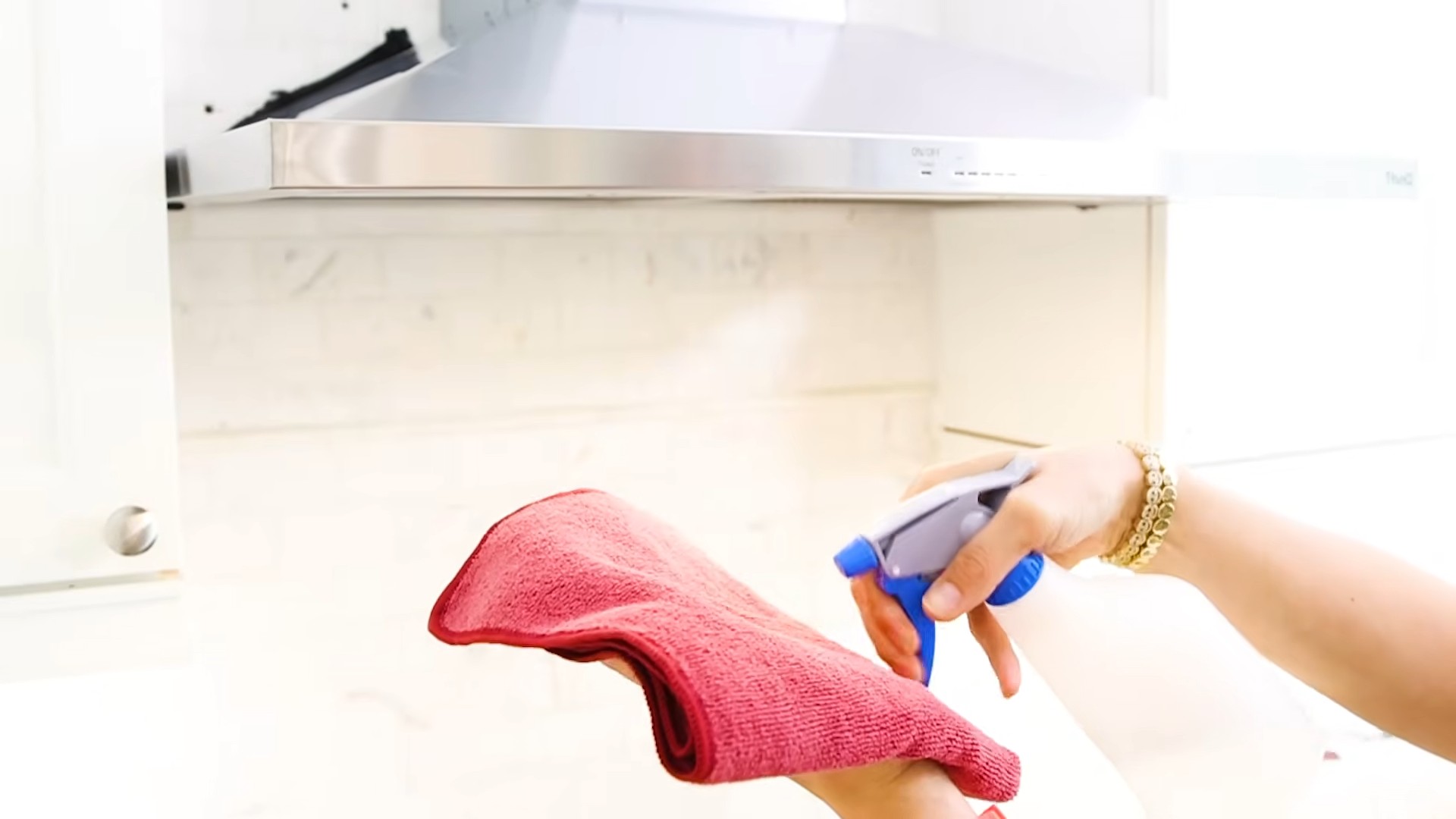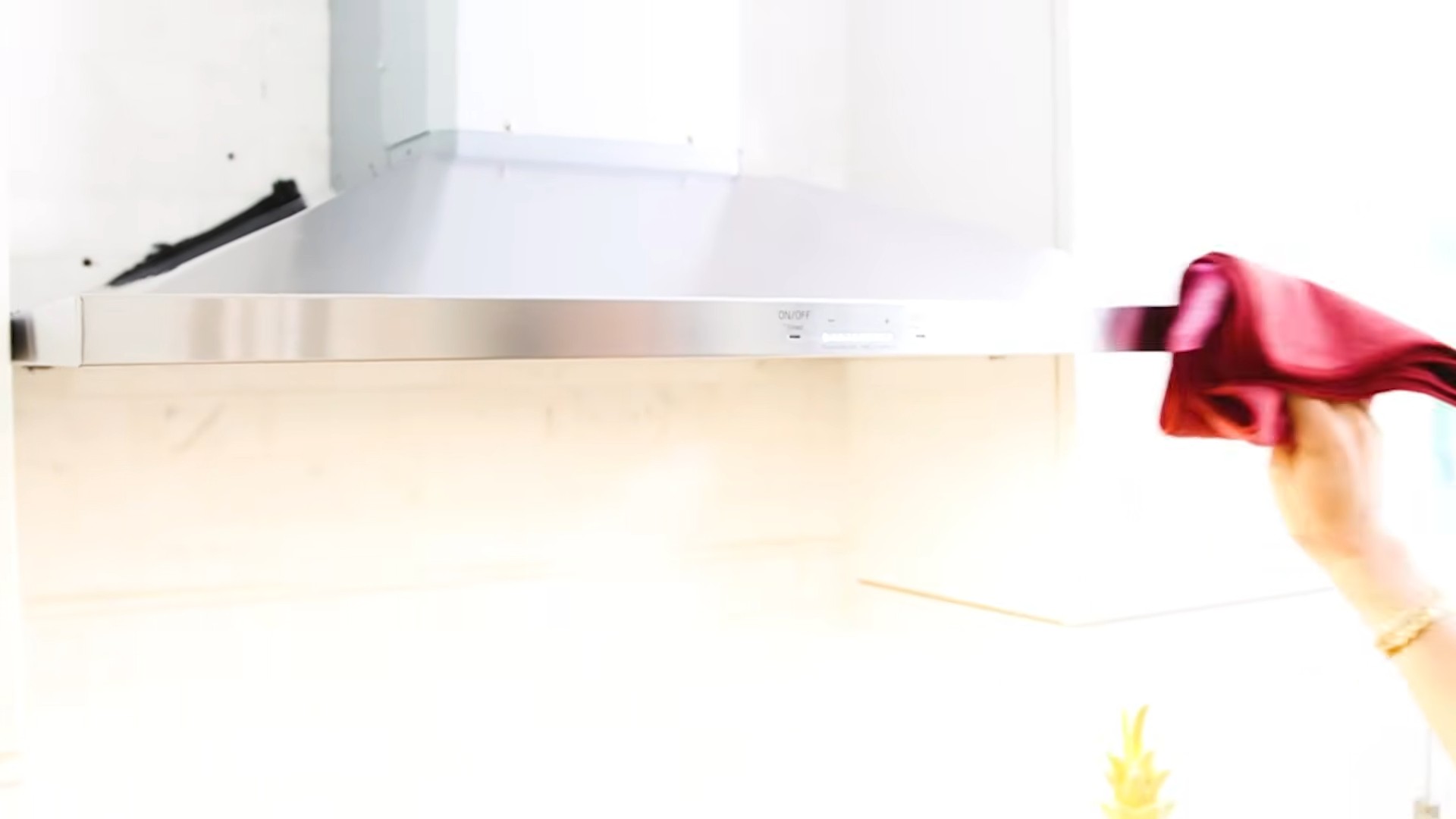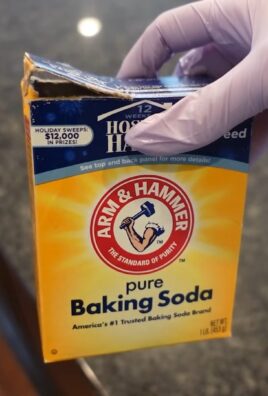Shine Stainless Steel with Oil: Are you tired of battling fingerprints, smudges, and watermarks on your stainless steel appliances? I know I am! It feels like no matter how much I clean, those pesky imperfections always reappear, leaving my kitchen looking less than its best. But what if I told you there’s a simple, inexpensive, and surprisingly effective way to achieve a lasting, brilliant shine using something you probably already have in your pantry?
The quest for gleaming stainless steel isn’t new. For decades, homeowners have sought the perfect solution to maintain the sleek, modern look that stainless steel brings to a kitchen. While commercial cleaners abound, many contain harsh chemicals and can be quite costly. This DIY trick, however, offers a natural and budget-friendly alternative, harking back to simpler times when resourceful home remedies were the norm.
Let’s face it, a sparkling kitchen is more than just aesthetically pleasing; it’s a reflection of our care and attention to detail. And that’s why learning how to shine stainless steel with oil is so valuable. This simple hack not only removes existing blemishes but also creates a protective barrier that helps prevent future smudges and fingerprints. Ready to ditch the expensive cleaners and embrace a natural, effective solution? Let’s dive in and discover how to transform your stainless steel from dull to dazzling with just a few drops of oil!

DIY: The Secret to Sparkling Stainless Steel with Just Oil!
Okay, friends, let’s talk stainless steel. We all love the sleek look, but those fingerprints and water spots? Not so much. I’ve tried countless cleaners, and honestly, some work okay, but nothing beats this simple, natural hack using something you probably already have in your pantry: oil! Yes, you read that right. Oil. It’s a game-changer.
This method is fantastic because it’s:
* Inexpensive: You’re using oil you already have!
* Non-toxic: No harsh chemicals involved.
* Effective: Seriously, the shine is incredible.
* Easy: It takes just a few minutes.
Ready to ditch the expensive stainless steel cleaners and embrace the power of oil? Let’s get started!
What You’ll Need
Before we dive in, gather your supplies. You won’t need much:
* Oil: I prefer mineral oil or baby oil because they’re odorless and food-safe, but you can also use olive oil, vegetable oil, or even coconut oil (melted, of course). Just be aware that olive and coconut oil might leave a slight scent.
* Two Microfiber Cloths: These are essential for streak-free results. One for applying the oil and one for buffing.
* Spray Bottle with Water (Optional): For pre-cleaning heavily soiled surfaces.
Step-by-Step Instructions: The Oil Shine Method
Here’s the breakdown of how to achieve that showroom-worthy shine:
1. Clean the Surface (If Needed): If your stainless steel is particularly dirty or greasy, start by cleaning it with warm, soapy water. This removes any surface grime that could interfere with the oil’s ability to create a smooth, even shine. Rinse thoroughly with clean water.
2. Dry Completely: This is crucial! Water and oil don’t mix, and any remaining water will prevent the oil from adhering properly and will leave streaks. Use a clean, dry microfiber cloth to thoroughly dry the stainless steel surface. Make sure you get into all the nooks and crannies.
3. Apply a Tiny Amount of Oil: This is where the magic happens! Pour a very small amount of oil (seriously, a teaspoon or less is usually enough for a large appliance) onto one of your microfiber cloths. The key is to use a minimal amount. Too much oil will make the surface greasy and attract dust.
4. Spread the Oil Evenly: Gently rub the oil onto the stainless steel surface, following the grain of the metal. This is important! Stainless steel has a grain, and rubbing with the grain will prevent streaks and create a more uniform shine. Use long, even strokes, ensuring you cover the entire surface.
5. Buff to a Shine: Now, grab your second, clean microfiber cloth. Use it to buff the oiled surface, again following the grain of the stainless steel. Apply gentle pressure and use circular motions to remove any excess oil and create a brilliant shine. This step is crucial for removing any residual oil and achieving that streak-free finish. Keep buffing until the surface feels smooth and dry to the touch.
6. Admire Your Work! Step back and admire your sparkling stainless steel! You’ll be amazed at how much better it looks.
Dealing with Specific Stainless Steel Items
The basic method is the same, but here are some tips for different items:
Stainless Steel Appliances (Refrigerators, Dishwashers, Ovens)
* Focus on Fingerprints: Appliances are fingerprint magnets! Pay special attention to areas around handles and doors.
* Large Surfaces: For large surfaces, work in sections. Apply oil to a small area, buff, and then move on to the next section. This prevents the oil from drying out before you have a chance to buff it.
* Avoid Control Panels: Be careful not to get oil on control panels or electronic displays. If you do, wipe it off immediately with a dry cloth.
Stainless Steel Sinks
* Dry Thoroughly: Sinks are constantly exposed to water, so drying them completely before applying the oil is essential.
* Pay Attention to Corners: Make sure to get into all the corners and crevices of the sink.
* Rinse After Oiling (Optional): If you’re concerned about oil residue in your sink, you can rinse it with warm water after buffing. Just be sure to dry it thoroughly again.
Stainless Steel Cookware
* Food-Safe Oil is Key: When cleaning cookware, always use a food-safe oil like mineral oil, vegetable oil, or olive oil.
* Exterior Only: This method is best for the exterior of your cookware. Avoid applying oil to the cooking surfaces.
* Wash Before Use: After cleaning your cookware with oil, wash it thoroughly with soap and water before using it for cooking.
Troubleshooting: Common Issues and Solutions
Even with the best instructions, sometimes things don’t go exactly as planned. Here are some common issues and how to fix them:
* Streaks: Streaks are usually caused by using too much oil or not buffing thoroughly enough. Try buffing the surface again with a clean, dry microfiber cloth. If that doesn’t work, dampen the cloth slightly with water and buff again.
* Greasy Feel: A greasy feel indicates that you’ve used too much oil. Buff the surface vigorously with a clean, dry microfiber cloth. You may need to repeat this several times to remove the excess oil.
* Dull Finish: A dull finish can be caused by using the wrong type of oil or not cleaning the surface properly beforehand. Make sure you’re using a clean microfiber cloth and the right type of oil. If the surface is heavily soiled, clean it with warm, soapy water before applying the oil.
* Dust Attraction: If your stainless steel is attracting dust, it’s likely because there’s still some oil residue on the surface. Buff the surface again with a clean, dry microfiber cloth to remove any excess oil.
Tips for Maintaining Your Shiny Stainless Steel
Once you’ve achieved that perfect shine, you’ll want to keep it that way! Here are some tips for maintaining your stainless steel:
* Regular Cleaning: Wipe down your stainless steel surfaces regularly with a damp microfiber cloth to remove fingerprints and water spots.
* Avoid Abrasive Cleaners: Abrasive cleaners can scratch stainless steel, so avoid using them.
* Dry Immediately: Always dry your stainless steel surfaces immediately after cleaning to prevent water spots.
* Reapply Oil as Needed: Depending on how often you use your stainless steel items, you may need to reapply the oil every few weeks or months to maintain the shine.
Why This Works: The Science Behind the Shine
You might be wondering why oil works so well on stainless steel. Here’s the simple explanation:
* Fills in Imperfections: Stainless steel, while seemingly smooth, has microscopic imperfections on its surface. The oil fills in these imperfections, creating a smoother, more reflective surface.
* Protective Barrier: The oil creates a thin, protective barrier that helps to repel water and fingerprints.
* Enhances Shine: The oil enhances the natural shine of the stainless steel, making it look brighter and more vibrant.
Choosing the Right Oil: A Deeper Dive
I mentioned earlier that I prefer mineral oil or baby oil, but let’s explore the different oil options in more detail:
* Mineral Oil: This is my top choice. It’s odorless, food-safe, and creates a beautiful, long-lasting shine. You can find it at most drugstores or pharmacies.
* Baby Oil: Similar to mineral oil, baby oil is also odorless and food-safe. It’s a good option if you already have it on hand.
* Olive Oil: Olive oil is a natural option, but it can leave a slight scent and may attract dust more easily. Use it sparingly.
* Vegetable Oil: Similar to olive oil, vegetable oil can also leave a slight scent and may attract dust. Use it sparingly.
* Coconut Oil: Coconut oil needs to be melted before use. It can leave a coconut scent and may solidify in cooler temperatures, so it’s not my first choice.
Ultimately, the best oil for you will depend on your personal preferences and what you have available. Experiment with different oils to see which one you like best.
I hope this guide helps you achieve the sparkling stainless steel of your dreams! It’s a simple, effective, and natural way to keep your appliances and cookware looking their best. Happy cleaning!

Conclusion
So, there you have it! Achieving a streak-free, dazzling shine on your stainless steel appliances and surfaces doesn’t require expensive, specialized cleaners. This simple, yet incredibly effective, DIY trick using oil is a game-changer for anyone looking to maintain the beauty and longevity of their stainless steel. It’s a cost-effective, readily available, and surprisingly powerful solution that will leave your kitchen looking its absolute best.
Why is this DIY method a must-try? Because it’s more than just a cleaning hack; it’s a preventative measure. The thin layer of oil not only removes existing smudges, fingerprints, and water spots, but it also creates a protective barrier against future blemishes. This means less frequent cleaning and a consistently polished appearance. Think of it as a shield against the daily wear and tear that dulls your stainless steel.
Beyond the basic method, there are several variations you can explore to tailor the process to your specific needs and preferences. For example, if you prefer a lighter scent, consider using lemon-infused olive oil or adding a few drops of your favorite essential oil (lavender, tea tree, or eucalyptus are excellent choices) to the oil before application. Just be sure to test a small, inconspicuous area first to ensure the essential oil doesn’t react negatively with the stainless steel. Another variation involves the type of cloth you use. While microfiber cloths are generally recommended, you can also experiment with soft cotton cloths or even old t-shirts. The key is to use a clean, lint-free material to avoid leaving behind any residue.
For those dealing with particularly stubborn stains or buildup, a pre-cleaning step with a mild dish soap and water solution may be necessary. Simply wash the stainless steel surface, rinse thoroughly, and dry completely before applying the oil. This will remove any grease or grime that could interfere with the oil’s ability to create a smooth, even shine.
We understand that trying new cleaning methods can sometimes feel daunting, but we wholeheartedly encourage you to give this DIY trick a try. The results speak for themselves, and we’re confident that you’ll be amazed at how easily you can transform your stainless steel from dull to dazzling. The best part? You’re likely to already have everything you need right in your pantry!
Don’t just take our word for it – experience the magic of using oil to shine stainless steel for yourself. We’re eager to hear about your experiences! Share your before-and-after photos, tips, and variations in the comments section below. Let’s create a community of stainless steel shining enthusiasts! Your insights could help others discover the joy of a sparkling clean kitchen. We believe that sharing our knowledge and experiences is the best way to learn and improve, so please don’t hesitate to contribute. Happy shining!
Frequently Asked Questions (FAQ)
1. What type of oil is best for shining stainless steel?
The best type of oil to use for shining stainless steel is generally mineral oil or olive oil. Mineral oil is a popular choice because it’s odorless, colorless, and doesn’t leave a sticky residue. It’s also readily available at most drugstores and supermarkets. Olive oil is a natural alternative that works well, but it’s important to use it sparingly to avoid a greasy buildup. Other options include baby oil (which is essentially mineral oil with added fragrance) and even coconut oil, although coconut oil can solidify at cooler temperatures, potentially making it more difficult to apply evenly. Ultimately, the best oil for you will depend on your personal preferences and what you have readily available. Experiment with different types to see which one gives you the best results.
2. Will using oil on stainless steel make it greasy or attract dust?
When applied correctly, using oil on stainless steel should not make it greasy or attract dust. The key is to use a very small amount of oil and to buff it in thoroughly with a clean, dry microfiber cloth. The goal is to create a thin, even layer of oil that protects the surface and enhances its shine, not to leave a thick, greasy film. If you find that your stainless steel feels greasy after applying the oil, you’ve likely used too much. Simply buff the surface again with a clean cloth to remove the excess oil. The protective layer of oil will actually help to repel dust and fingerprints, keeping your stainless steel looking cleaner for longer.
3. How often should I apply oil to my stainless steel appliances?
The frequency with which you need to apply oil to your stainless steel appliances will depend on how often they are used and exposed to fingerprints, water spots, and other blemishes. As a general guideline, you can apply oil every one to two weeks, or as needed. If you notice that your stainless steel is starting to look dull or is accumulating fingerprints and smudges, it’s time for another application. Regular maintenance will help to keep your stainless steel looking its best and will prevent the buildup of stubborn stains.
4. Can I use this method on all types of stainless steel?
This method is generally safe to use on most types of stainless steel, but it’s always a good idea to test it on a small, inconspicuous area first to ensure that it doesn’t cause any discoloration or damage. Different grades of stainless steel may react differently to certain oils, so it’s better to be safe than sorry. Avoid using abrasive cleaners or harsh chemicals on your stainless steel, as these can scratch or damage the surface. If you’re unsure about the type of stainless steel you have, consult the manufacturer’s instructions or contact a professional cleaner.
5. What if I don’t have microfiber cloths? What else can I use?
While microfiber cloths are generally recommended for shining stainless steel because they are soft, absorbent, and lint-free, you can use other types of cloths if you don’t have any microfiber cloths on hand. Soft cotton cloths, such as old t-shirts or flannel rags, can also work well. Just make sure that the cloth is clean, dry, and free of any loose fibers that could leave behind residue on the stainless steel surface. Avoid using paper towels, as they can be abrasive and may scratch the stainless steel.
6. Is this method safe for stainless steel appliances that come into contact with food?
Yes, this method is generally safe for stainless steel appliances that come into contact with food, as long as you use food-grade oil, such as olive oil or mineral oil. However, it’s important to wipe down the surface thoroughly with a clean, damp cloth after applying the oil to remove any excess residue. This will prevent any oil from coming into contact with food. You can also use a food-safe stainless steel cleaner specifically designed for appliances that come into contact with food.
7. Can I use this method on brushed stainless steel?
Yes, you can use this method on brushed stainless steel, but you need to be careful to apply the oil in the direction of the grain. This will help to avoid creating streaks or unevenness. Use a soft cloth and gentle pressure to apply the oil, and buff it in thoroughly with a clean, dry cloth. It’s also a good idea to test the method on a small, inconspicuous area first to ensure that it doesn’t damage the brushed finish.
8. How do I remove stubborn stains from stainless steel before applying the oil?
For stubborn stains on stainless steel, you can try a few different methods before applying the oil. One option is to make a paste of baking soda and water and apply it to the stain. Let it sit for a few minutes, then gently scrub with a soft cloth or sponge. Rinse thoroughly with water and dry completely before applying the oil. Another option is to use a commercial stainless steel cleaner specifically designed for removing stubborn stains. Follow the manufacturer’s instructions carefully. For water spots, try wiping the surface with white vinegar, then rinsing with water and drying thoroughly.




Leave a Comment